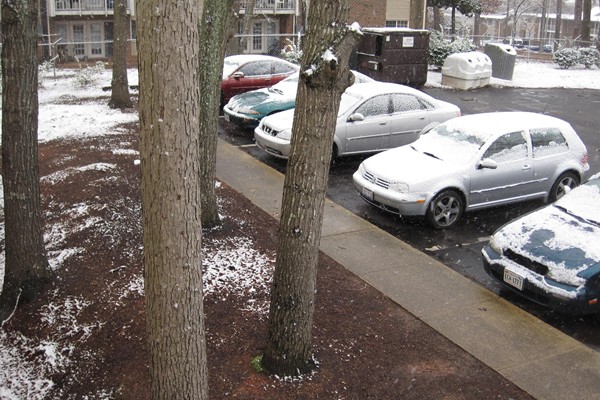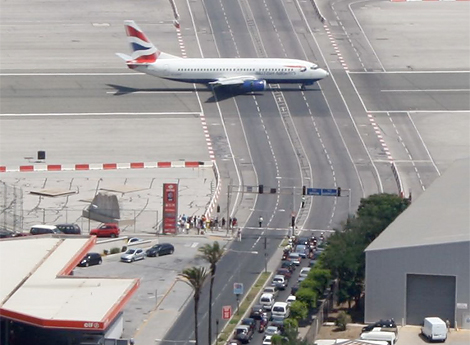A winter storm off the coast of North Carolina has brought snow to both Chicago and Raleigh:
25 mm of snow had fallen at O'Hare by 8:30 p.m. Wednesday, with snow still coming down hard. That was enough to push the city's official seasonal snow tally above 127 cm for the third consecutive year. There's been only one other string of three consecutive 50+ inch seasons in 125 years of snow measurements here and it occurred between 1976 to 1979.
Lake effect snows occur in especially cold environments which, because of the efficiency of ice crystal formation at low temperatures, frequently produce larger than typical accumulations from the limited amount of water vapor available. This leads to snowflakes which exhibit maximum "fluff". Estimates of Wednesday's snow puts snow/water ratios at 30 to 1---indicating the system's snowflakes had almost three times the volume of those which come down in more typical 10 to 1 ratio snow events. One witness, in describing the rate of snowfall in Evanston, compared the scene to a "snow globe." Another described "pure whiteout conditions with snow coming in horizontally" and still another characterized the snowfall intensity at its height Wednesday evening as "this season's heaviest."
In North Carolina the snow is causing the same kinds of disruptions as in Chicago—slow traffic, nervous parents, confused dogs—but...well, it's not quite as much snow:

But I have to agree with my friend Jamie, who, when I mentioned the comparison, said "you picked a good winter to stay in North Carolina." I'm thinking she's right.
If this story is true, someone needs time in jail to think about civic responsibility:
In a lawsuit filed Tuesday in federal court, [a Pennsylvania] family said the school's assistant principal had confronted their son, told him he had "engaged in improper behavior in [his] home, and cited as evidence a photograph from the webcam embedded in [his] personal laptop issued by the school district."
The suit contends the Lower Merion School District, one of the most prosperous and highest-achieving in the state, had the ability to turn on students' webcams and illegally invade their privacy.
The suit says that in November, assistant principal Lynn Matsko called in sophomore Blake Robbins and told him that he had "engaged in improper behavior in his home," and cited as evidence a photograph from the webcam in his school-issued laptop.
Matsko later told Robbins' father, Michael, that the district "could remotely activate the webcam contained in a student's personal laptop . . . at any time it chose and to view and capture whatever images were in front of the webcam" without the knowledge or approval of the laptop's users, the suit says.
A security professional in New York has investigated the technical claims and found them convincing. He also expanded on the original news story with some circumstantial evidence:
The truly amazing part of this story is what's coming out from comments from the students themselves. Some of the interesting points:
- Possession of a monitored Macbook was required for classes
- Possession of an unmonitored personal computer was forbidden and would be confiscated
- Disabling the camera was impossible
- Jailbreaking a school laptop in order to secure it or monitor it against intrusion was an offense which merited expulsion
When I spoke at MIT about the wealth of electronic evidence I came across regarding Chinese gymnasts, I used the phrase "compulsory transparency". I never thought I would be using the phrase to describe America, especially so soon, but that appears to be exactly the case.
I can't wait to see how this turns out.
Via Going Green @ Your Library, an elucidation of everything you need to know about grocery bags. But:
Ultimately, neither paper nor plastic bags are the best choice; we think choosing reusable canvas bags instead is the way to go. From an energy standpoint, according to this Australian study, canvas bags are 14 times better than plastic bags and 39 times better than paper bags, assuming that canvas bags get a good workout and are used 500 times during their life cycle. Happy shopping!
Top Palin aide Meghan Stapleton quit today, with this statement:
"While I had hoped to work together on so many more projects, time with my precious 2-year-old has been further minimized with the whirlwind commitments of all things Palin,” she told the SarahPAC staff. “I have done my best to scale back, but [my two-year-old daughter] Isabella is now resorting to hiding my BlackBerry, and she shouldn't grow up begging for a mother to start acting like a mother.”
With friends like these...who needs to carry her kid around like a prop?
Life Goes On alumna Andrea Fay Friedman speaks out about Sarah Palin using Trig as a prop:
I'm splitting my time between Chicago and Raleigh lately, and it looks like I'll continue to do so for quite a while. This causes one minor inconvenience: my car doesn't fit in the overhead compartment on a CRJ. (For that matter, an anorexic gerbil won't fit in the overhead compartment on one of those things, but that's another issue.)
 Chicago, however, is a major city with an extensive public transportation system (no snickering from natives, please). Chicago also has Zipcars, a by-the-hour car-rental cooperative, with six cars stationed less than four blocks from my house. Four blocks—800 m—seems to suburbanites like a very long walk to get a car, but actually, I'm lucky if I get to park my own car that close most days. So this is an improvement.
Chicago, however, is a major city with an extensive public transportation system (no snickering from natives, please). Chicago also has Zipcars, a by-the-hour car-rental cooperative, with six cars stationed less than four blocks from my house. Four blocks—800 m—seems to suburbanites like a very long walk to get a car, but actually, I'm lucky if I get to park my own car that close most days. So this is an improvement.
iGo, which costs a little less and works in partnership with the CTA, is another option. Unfortunately they don't have any cars within 1500 m of my house. Walking around the block to get the Zipcar suddenly seems more attractive. Walking eight blocks to get a car is less so.
Zipcars also has the advantage of national reach. Given how often I travel (especially to San Francisco), this has tremendous appeal.
Now if only Chicago had a puppy-rental service for those times when I miss Parker...
These are kind of cool:

Winston Churchill Avenue, Gibraltar's busiest road, cuts directly across the runway. Railroad-style crossing gates hold cars back every time a plane lands or departs. "There's essentially a mountain on one side of the island and a town on the other," Schreckengast says. "The runway goes from side to side on the island because it's the only flat space there, so it's the best they can do. It's a fairly safe operation as far as keeping people away," he says, "It just happens to be the best place to land, so sometimes it's a road and sometimes it's a runway."
Number 8, St. Maarten's Princess Juliana, is one of my favorites.
You really have them:
Technically known as the enteric nervous system, the second brain consists of sheaths of neurons embedded in the walls of the long tube of our gut, or alimentary canal, which measures about nine meters end to end from the esophagus to the anus. The second brain contains some 100 million neurons, more than in either the spinal cord or the peripheral nervous system, [says Michael Gershon, chairman of the Department of Anatomy and Cell Biology at New York–Presbyterian Hospital/Columbia University Medical Center].
... "The system is way too complicated to have evolved only to make sure things move out of your colon," says Emeran Mayer, professor of physiology, psychiatry and biobehavioral sciences at the David Geffen School of Medicine at the University of California, Los Angeles (U.C.L.A.). For example, scientists were shocked to learn that about 90 percent of the fibers in the primary visceral nerve, the vagus, carry information from the gut to the brain and not the other way around. "Some of that info is decidedly unpleasant," Gershon says.
There are some intriguing corollaries to this:
Scientists are learning that the serotonin made by the enteric nervous system might also play a role in more surprising diseases: In a new Nature Medicine study published online February 7, a drug that inhibited the release of serotonin from the gut counteracted the bone-deteriorating disease osteoporosis in postmenopausal rodents. (Scientific American is part of Nature Publishing Group.) "It was totally unexpected that the gut would regulate bone mass to the extent that one could use this regulation to cure—at least in rodents—osteoporosis," says Gerard Karsenty, lead author of the study and chair of the Department of Genetics and Development at Columbia University Medical Center.
... Serotonin seeping from the second brain might even play some part in autism, the developmental disorder often first noticed in early childhood. Gershon has discovered that the same genes involved in synapse formation between neurons in the brain are involved in the alimentary synapse formation. "If these genes are affected in autism," he says, "it could explain why so many kids with autism have GI motor abnormalities" in addition to elevated levels of gut-produced serotonin in their blood.
Scientific American also investigates whether untreated vision problems lead to age-related dementia. Very interesting.
I'm not even going to bother explaining this.
I remembered one anniversary on the right day but totally forgot another one: ten years ago January 15th, I passed my private pilot checkride.